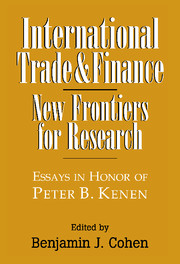Book contents
- Frontmatter
- Contents
- List of contributors
- Introduction
- 1 The practical theorist: Peter Kenen's contribution to international economics
- I International trade theory
- II International monetary theory
- 5 Exchange rate regimes and international trade
- 6 Exchange rates and investment response in Latin America
- 7 Optimum currency areas and exchange rate volatility: Theory and evidence compared
- 8 Optimum currency area theory: Bringing the market back in
- III Applied policy analysis
- Index
5 - Exchange rate regimes and international trade
Published online by Cambridge University Press: 11 September 2009
- Frontmatter
- Contents
- List of contributors
- Introduction
- 1 The practical theorist: Peter Kenen's contribution to international economics
- I International trade theory
- II International monetary theory
- 5 Exchange rate regimes and international trade
- 6 Exchange rates and investment response in Latin America
- 7 Optimum currency areas and exchange rate volatility: Theory and evidence compared
- 8 Optimum currency area theory: Bringing the market back in
- III Applied policy analysis
- Index
Summary
Introduction
Empirical applications of the theory of exchange rate regime choice and optimal currency areas typically have involved estimating the effects of exchange rate risk on international trade flows. A finding that a measure of greater exchange rate risk or variability dampens the volume of international trade is interpreted as evidence against the desirability of adopting a floating rate regime (Cushman 1983, 1986; Akhtar and Hilton 1984; Kenen and Rodrik 1986). In actuality, it has proven difficult to establish empirically an unambiguous relation between exchange rate risk measures and trade flows, or a clear correspondence between a country's exchange rate regime and the level of risk.
There are several reasons why research has failed to establish clear relations among risk, exchange rate regimes, and trade flows. First, the relation between exchange rate variability and risk exposure under different exchange rate regimes is tenuous. If, for example, exchange rate fluctuations work to stabilize output in a country subject to aggregate demand shocks, a firm's overall uncertainty about macroeconomic shocks may decrease rather than increase with increased exchange rate variability. Thus, greater exchange rate variability does not necessarily imply greater exposure to risk. Second, the time variation in the subjective evaluation of risk is hard to capture with empirical proxies. This difficulty is particularly acute under pegged exchange rates when exchange rates change infrequently, but uncertainty exists about continued maintenance of the peg.
- Type
- Chapter
- Information
- International Trade and FinanceNew Frontiers for Research, pp. 125 - 156Publisher: Cambridge University PressPrint publication year: 1997
- 6
- Cited by



